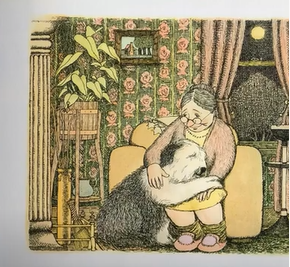When you think about picture books I am sure you think about the combination of words and illustrations and of course both are very important but in this post I would like to reflect on the importance and variety of illustrations themselves found in the books we share with our children.
I am by no means claiming any expertise in this area. There are picture books that contain art I love, picture books that contain art I truly appreciate and of course picture books where the art style or images created by the illustrator do not appeal to me. Surely these reactions are formed by experience. This why I argued previously that we should try to share a range of picture books with our students making sure to add titles from around the world.
In her book Looking at Pictures in Picture Books (Thimble Press 1993) Jane Doonan delineates the value of the visual element in picture books:
- Pictures provide children with 'sensuous pleasure for the eye'.
- Pictures are a 'means to an end - an aid to literacy and language development'.
- Pictures enable the book 'to function as an art object. ... The value in this case lies in the aesthetic experience ... ".
Some parts of a picture book that you need to notice:
- Size and Shape of the book itself
- Cover
- Endpapers
- Choice of Paper
- Style: Charcoal illustration; Ink illustration; Woodcut illustration; Watercolor; Pencil Illustration; Collage Illustration; Acrylic Illustration
- Type of illustrations: Vignette; Spot; Framed; Full Bleed
- Size of the illustrations
- Layers of details
- Colours
- Perspective and Point of View
- Emotional impact of the illustrations
Talking about the illustrations in a picture book:
- Are the pictures or the words more important in the book? Or do they both matter equally?
- Do you like the pictures? Why or why not?
- What about the pictures do you notice?
- Would the story be different if it had no pictures? If so, how?
- Do you think this book is art? Why or why not?
- The Caldecott Medal
- Ezra Jack Keates Award
- Charlotte Zolotow Award
- Batchelder Award
- Boston Globe - Horn Book Awards - Picture Book
- The Klaus Flugge Prize
- The Kate Greenaway Medal
- The Lollies
- Sainsbury's Children's Book Award
- UKLA Award
- English 4-11 Picture Book Award
- Book Trust Storytime Prize
- Children's Book Council of Australia (CBCA) awards
ILLUSTRATIONS -
- The quality of medium use is excellent for the intended audience.
- The illustrations are fully entwined with all the text on page and this enhances/augments the storyline.
- Illustration/s reflect/s the quality of the text on each page.
- The layout of illustrations provides a balance of space and text.
- There a consistent quality of illustration throughout the book.
- The artistic style, media and artistic elements of colour, line, shape and texture match to the written text or idea.
- The illustrations in the book also help to fully engage the reader who can identify with characters.
- The use of various media by the illustrator contribute to the aesthetic qualities of the book.
- Illustrations are credible and appropriate in the use of cultural material.
MOOD -
- The illustrator creates, develops, varies and sustains the mood successfully, engaging the reader fully.
- The illustrator’s work and colour palette augment the mood of the book.























No comments:
Post a Comment